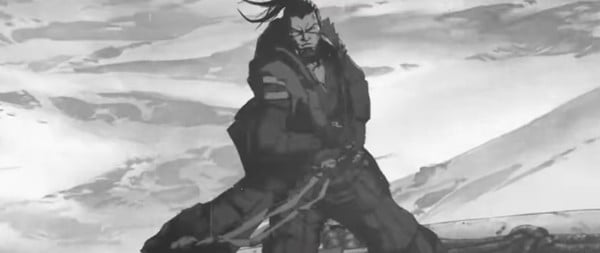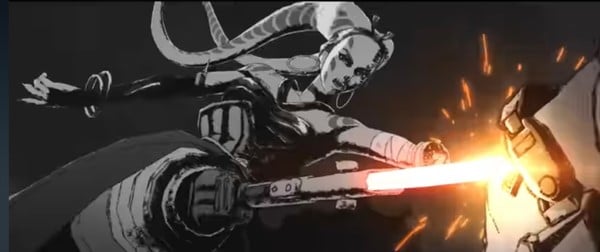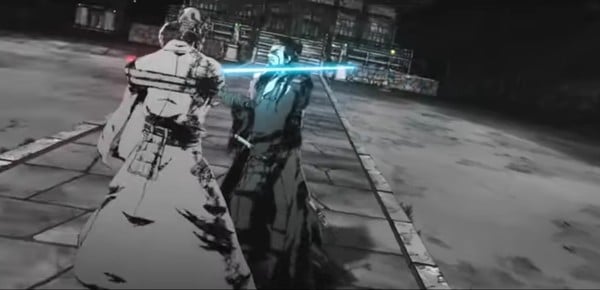Ronin and Sith Reunite in Star Wars Visions The Duel: Payback
by Bolts,Star Wars: Visions is a unique property that allows various animators to create short-form features set in the Star Wars universe, each with their distinct styles. This has led to a variety of different “what if” scenarios with unique stories or reimaginings found in a galaxy far, far away. Star Wars: Visions Volume 3 is slated to premiere on October 29, and several of the shorts featured in season three are canonical sequels to a short that was shown in season one. One such short is The Duel.
The Japan Society in New York City hosted a special screening of this follow-up episode titled The Duel: Payback at the Japan Society in New York. After a dual screening (see what I did there?) of both The Duel and The Duel: Payback, we were also treated to an exclusive Q&A video with director Takanobu Mizuno. He shared what it was like bringing these visions to life with Kamikaze Douga, who oversaw animation production of both shorts, while also sharing insight into what he hoped the stories would accomplish.

Personally, I will say that The Duel was one of my favorite shorts in the first season. That short was straightforward in its execution, telling the story of a ronin, or a samurai without a master, who just happens upon a small village that is about to be destroyed by the Empire. Despite the villagers fighting back, they are immediately overwhelmed once they realize that a Sith accompanies a group of Stormtroopers with a very unique red lightsaber. This nameless ronin chooses to get involved and takes care of the Sith to confiscate the red Kyber crystal in her lightsaber, but not without revealing that he himself is also a former Sith.
Despite that simple setup, what really sells the short is the style and atmosphere. The entire presentation is in black-and-white stylized 3D, with the only real splash of color coming from stray lights and the lightsabers. Mizuno explained during the Q&A video that both shorts were heavily inspired by Japanese period dramas, which sometimes depicted roaming samurai. This is noteworthy because George Lucas himself had noted at least a few direct Japanese inspirations in crafting the world of Star Wars. Seeing Stormtroopers clad in Edo-style samurai gear and lightsabers treated like katana creates this full-circle cultural moment. Mizuno even admitted that this short in particular was also meant to be a throwback to Star Wars Episode IV while the follow-up sequel was meant to be a throwback to Episodes V and VI.
It is much more noticeable in The Duel: Payback, which has many more moving parts figuratively and literally. We have the same ronin breaking up a gambling ring taking place in an abandoned, turned-upside-down Walker on a winter mountain, which evokes clear parallels to the beginning of Star Wars episode V. While trying to take on another Sith lord, their duel gets interrupted by a mysterious Jedi who appears to have a history with our mysterious Ronin. Apparently, this man is known as the Grandmaster and is doing his best to kill Siths in an attempt to carry out his own sick, twisted sense of justice. To do this, he uses a variety of different mechanical limbs to perform incredible leaps of strength and speed while also inhibiting his own emotions. After initially being overwhelmed by this so-called Jedi, Ronin retreats and finds himself on a small artificial island surrounded by Ewoks. Now we are suddenly in the climax of Star Wars Episode VI where the Ronin coordinates with these Ewoks, some criminals, and a Sith to take down the Grandmaster.

The style of The Duel: Payback is highly similar to its predecessor, though I will admit it did feel a lot more cluttered. There were more characters introduced with the same amount of runtime as the first part, so there were moments where it was hard to keep track of everything. While I still think the black-and-white period drama style is unique, some designs or animation choices made it very hard to see. This is most notable when it comes to mechanical parts versus organic ones. The Grandmaster's choreography did get difficult to see, especially when the animation started implementing afterimages to properly convey how much faster he was than everyone else. In the middle of a choreographed fight, it became difficult to properly register what was taking place.
We get some more diverse set pieces, like a large bridge and a hot spring, which was considered the site of the final fight. Mizuno explained that they wanted to showcase as much Japanese iconography as possible, as they see these shorts as a great way to introduce Japanese settings and culture to a broad audience. The final fight even takes place in front of a shrine, but the trade-off seems to be that the fights feel slightly less intimate, which is a shame considering the more personal motivation between our protagonist and antagonist.

Despite that, the themes of the short are significantly stronger compared to The Duel. We get a little bit more insight into exactly who this Ronin is, and despite wielding a red lightsaber, his values don't come off as traditionally Sith-like. Inversely, the Grandmaster had many parallels to Darth Vader himself, becoming more machine than man and using his desire for order as an excuse to fulfill selfish desires. If you're a longtime Star Wars fan that has read up on the history of the Sith, then these parallels should be made apparent. However, I am very curious about who exactly our Ronin protagonist is, because the short keeps it intentionally vague about the reason these two had a conflict in the past.
Mizuno explained that he wants to do more stories with Ronin in the future. While he made it clear he wants to keep those stories in as many Japanese locations as possible, he is open to Ronin doing more in the larger universe. He even suggested some potential space combat. Listening to Mizuno talk about working with the art designer on these pieces really showcases the care that went into crafting these shorts. I know that opinions about the more recent installments in the Star Wars franchise have been mixed. But if we keep getting incredibly talented people telling these kinds of stories that showcase various cultures in ways that feel fitting with the larger Star Wars universe, then I won't complain.
discuss this in the forum |